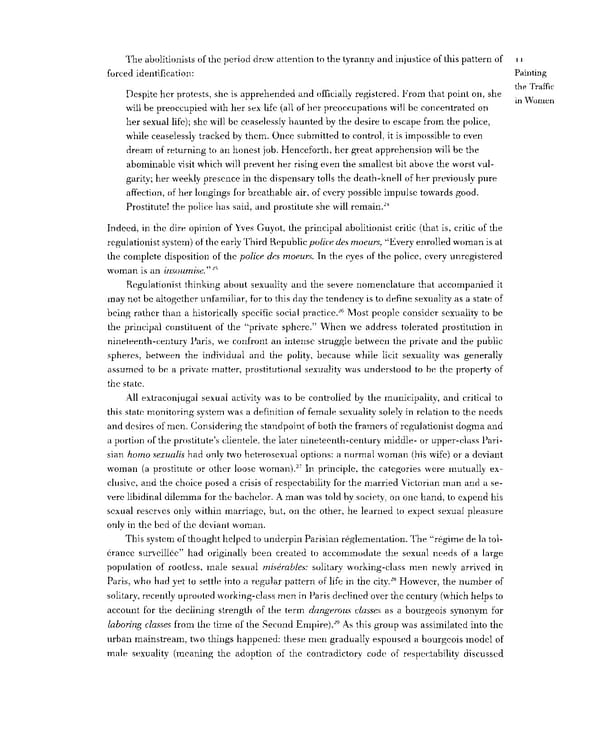The abolitionists of the period drew attention to the tyranny and injustice of this pattern of 11 forced identification: Painting Despite her protests, she is apprehended and officially registered. From that point on, she the Traffic will be preoccupied with her sex life (all of her preoccupations will be concentrated on in Women her sexual life); she will be ceaselessly haunted by the desire to escape from the police, while ceaselessly tracked by them. Once submitted to control, it is impossible to even dream of returning to an honest job. Henceforth, her great apprehension will be the abominable visit which will prevent her rising even the smallest bit above the worst vul- garity; her weekly presence in the dispensary tolls the death-knell of her previously pure affection, of her longings for breathable air, of every possible impulse towards good. 24 Prostitute! the police has said, and prostitute she will remain. Indeed, in the dire opinion of Yves Guyot, the principal abolitionist critic (that is, critic of the regulationist system) of the early Third Republic police des moeurs, "Every enrolled woman is at the complete disposition of the police des moeurs. In the eyes of the police, every unregistered woman is an insoumise."25 Regulationist thinking about sexuality and the severe nomenclature that accompanied it may not be altogether unfamiliar, for to this day the tendency is to define sexuality as a state of 26 being rather than a historically specific social practice. Most people consider sexuality to be the principal constituent of the "private sphere." When we address tolerated prostitution in nineteenth-century Paris, we confront an intense struggle between the private and the public spheres, between the individual and the polity, because while licit sexuality was generally assumed to be a private matter, prostitutional sexuality was understood to be the property of the state. All extraconjugal sexual activity was to be controlled by the municipality, and critical to this state monitoring system was a definition of female sexuality solely in relation to the needs and desires of men. Considering the standpoint of both the framers of regulationist dogma and a portion of the prostitute's clientele, the later nineteenth-century middle- or upper-class Pari- sian homo sexualis had only two heterosexual options: a normal woman (his wife) or a deviant 27 woman (a prostitute or other loose woman). In principle, the categories were mutually ex- clusive, and the choice posed a crisis of respectability for the married Victorian man and a se- vere libidinal dilemma for the bachelor. A man was told by society, on one hand, to expend his sexual reserves only within marriage, but, on the other, he learned to expect sexual pleasure only in the bed of the deviant woman. This system of thought helped to underpin Parisian reglementation. The "regime de la tol- erance surveillee" had originally been created to accommodate the sexual needs of a large population of rootless, male sexual miserables: solitary working-class men newly arrived in 28 Paris, who had yet to settle into a regular pattern of life in the city. However, the number of solitary, recently uprooted working-class men in Paris declined over the century (which helps to account for the declining strength of the term dangerous classes as a bourgeois synonym for 29 laboring classes from the time of the Second Empire). As this group was assimilated into the urban mainstream, two things happened: these men gradually espoused a bourgeois model of male sexuality (meaning the adoption of the contradictory code of respectability discussed
 Prostitution & Impressionists Page 31 Page 33
Prostitution & Impressionists Page 31 Page 33